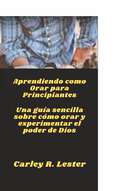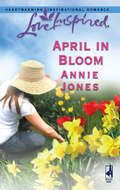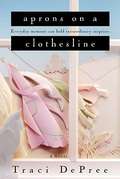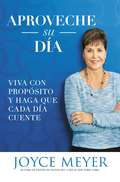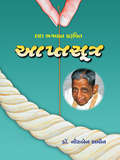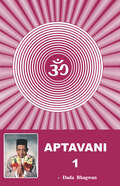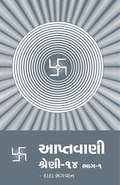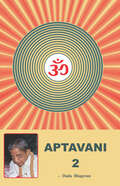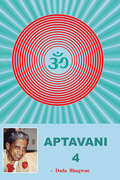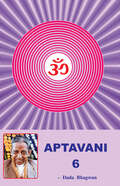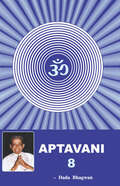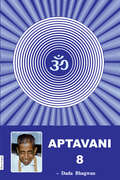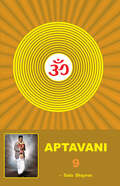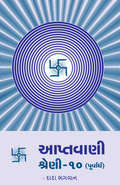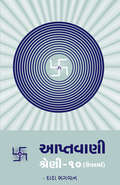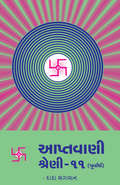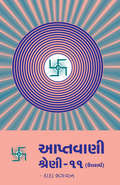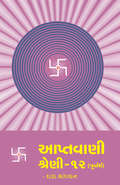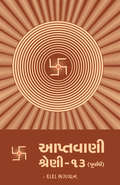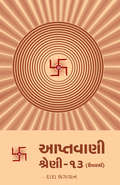- Table View
- List View
Aprendiendo como Orar para Principiantes: Una guía sencilla sobre cómo orar y experimentar el poder de Dios
by Carley R. LesterAprendizaje para comunicarse con el Espíritu Santo para todos. Se nos ha enseñado desde la infancia que la oración tiene tanto poder y que la comunicación constante con el Todopoderoso es la manera de experimentar la extraordinaria naturaleza de Dios y construir una relación íntima con Él. La cuestión aquí, sin embargo, es que solo un puñado de personas saben cómo orar verdaderamente en el verdadero sentido de la palabra y la acción. En esta guía, he delineado y explicado lo que es la oración y cómo orar sin esfuerzo y concisamente. "Aprendiendo a orar para principiantes" te guiará sobre cómo orar en ciertos momentos y en situaciones específicas. Con las oraciones vienen abundantes bendiciones y fomenta una relación más cercana y duradera con su Creador. La oración no tiene que ser una tarea o ser tan monótona como tú debes haber observado. Es un acto hermoso y saludable que debe ser poderoso y personal. Usted aprenderá cómo establecer su vida de oración y en el proceso desarrollar su estilo único de oración. La oración debe venir de un lugar de humildad y disposición para experimentar verdaderamente el asombroso poder del Espíritu Santo. Tu persona más íntima será iluminada creando un patrón divino de verdadera adoración, petición e intercesión con la presencia de la Santísima Trinidad a tu alrededor en todo momento. Este libro sobre cómo orar ofrece una nueva perspectiva sobre cómo acercarse a Dios, y está repleto de mucho poder, y es muy simple. Tu vida sufrirá un gran giro alrededor de toda la Gloria de Dios. Da ese paso en la dirección correcta hoy.
April Gold (Grace Livingston Hill #27)
by Grace Livingston HillMarilla Reed had spent her whole life in the warm comfort of a well-to-do household. Then, suddenly, her entire family was plunged into poverty. From the depths of desperation, Marilla found the satisfaction of fending for herself. And the infinite joys of falling in love. Grace Livingston Hill has created thrilling stories of inspiring wholesome people whose ardent faith and overflowing hearts cope triumphantly with the problems of the modern world. Bookshare has nearly all of her 100 books as well as her biography written by her son in law.
April in Bloom
by Annie JonesSheriff Kurt Mulldoon had moved to a home out of town to getaway from meddling townspeople and attractive women, but one of each was standing on his front porch. It seemed ninety-year-old Miss Cora, his house's previous owner, had convinced the one woman who piqued Kurt's fancy, April Shelnutt, to take her for a visit. And not long after they arrived, Cora suffered an injury-to her backside. Kurt's neighborly duty meant he'd offer his help, and let them into his home. But he wasn't letting April into his heart, no matter how pretty-and right-she looked standing in his doorway.
Aprons on a Clothesline (Lake Emily #3)
by Traci DepreeFilled with the enchantment that makes Lake Emily everyone's hometown, ""Aprons on a Clothesline" is a lovely reminder that hope can be found even in the tragedies of life and that joy waits in the most unexpected places.
Aprovecha bien el tiempo: Una guía práctica para honrar a Dios con tu día
by Ana Avila¿Cómo puedes ser más efectivo al buscar vivir para la gloria de Dios? Aprovecha bien el tiempo cambiará tu forma de ver la productividad como un concepto fundamental que te ayudará a ser eficiente y organizado en tu vida y en todo lo que emprendas. Trabajas todo el tiempo, pero sientes que nunca satisfaces tus expectativas? Sientes que te esfuerzas demasiado, que trabajas largas horas, pero siempre te quedas corto con los resultados. Al final, terminas preguntándote, «¿qué estoy haciendo mal? ¿Qué es lo que me falta?».Quizás te encuentras en el otro extremo y nunca has pensado demasiado en alcanzar grandes objetivos. Te has acostumbrado a enfrentar la vida conforme a lo que se te presenta por delante. Los planes no son lo tuyo, pero hubo un momento en que te preguntaste: «¿Cómo llegué aquí? Seguramente tiene que haber algo más que ir flotando por la vida».En este libro descubriremos que sí; hay mucho más.Aprovecha bien el tiempo cambiará la manera en que entiendes la productividad a través de seis principios, para que puedas ser eficiente y organizado en todas las áreas de tu vida:Tiempo: Tienes tiempo para hacer lo que deberías estar haciendo.Límites: No puedes hacerlo todo.Decisiones: No tienes que hacerlo todo.Enfoque: Si no fijas los ojos en la meta, acabarás perdido.Hábitos: Cada paso en la dirección correcta, cuenta.Herramientas: Tu cerebro fue creado para crear, no para almacenar.En Aprovecha bien el tiempo aprenderás que ser productivo no es algo demasiado complicado. Ser productivo es vivir la vida que Dios te ha llamado a vivir, para Su gloria y el bien de los demás. Make the Most of Your Time. How can you be more effective in living for the glory of God? Make the Most of Your Time will change the way you see productivity as a fundamental concept to help you be efficient and organized in your life and in everything you do. Do you work all the time, but feel like you never meet your expectations? Do you feel that you try hard, work long hours, but still fall short with your intended results? In the end, do you find yourself asking, "What am I doing wrong?” “What am I missing?” Maybe you're at the other end of the spectrum and have never given much thought to achieving big goals. You've grown accustomed to living life as it comes, without planning. But then there came a moment when you asked yourself, "How did I get here? Surely there must be more to life than just going with the flow. ”In this book we will discover that there IS much more.Make the Most of Your Time will change your view of productivity through six principles that will revolutionize the way you approach your daily tasks:Time: You have time to do what you SHOULD be doing.Limits: You can't do everything. Decisions: You don't have to do it all.Focus: If you don't keep your eyes on the goal, you will fail. Habits: Every step in the right direction, counts.Tools: Your brain was created to create, not just to store information.
Aproveche su día: Viva con propósito y haga que cada día cuente
by Joyce Meyer#1 New York Times bestselling author Joyce Meyer shares a purposeful approach to everyday living, helping readers claim the good things God has in store for them each day. Today is no ordinary day. You may perform simple routines, feel uninspired, or lack the excitement of hope. But today could be the most important one of your life--depending on how you choose to spend it.Joyce Meyer, #1 New York Times bestselling author, encourages you not to waste another minute. There is something special, valuable waiting for you to discover in each day. And when you spend time with God daily, asking Him to help you find it, you'll unlock the wonderful purpose He has in store for you. When you commit to letting God direct you, instead of resting passively in your own disappointments, you'll be open to receive greater happiness and blessings than you ever thought possible.All you need is the right encouragement. With over four decades of experience helping others find fulfillment, Joyce shares key biblical insights and personal stories that will help you make the most of this moment and SEIZE THE DAY!
Aptasutra Part 1: આપ્તસૂત્ર - ૧
by Dada Bhagwanપ્રસ્તુત પુસ્તકોના સેટમાં પરમ પૂજ્ય ‘દાદા ભગવાન’ના શ્રીમુખેથી વહેલ આત્મવિજ્ઞાનને સૂત્રમાં સંકલિત કરવામાં આવ્યું છે. પ્રત્યેક સૂત્ર સ્વતંત્ર તેમજ અનુસંધાનયુક્ત છે. એક એક સૂત્ર સામાન્ય સમજથી ઠેઠ કેવળ જ્ઞાનમાં સંપૂર્ણ સર્વાંગ ફોડ આપનારા તેમજ વ્યવહારના પ્રશ્નોથી માંડીને ગુહ્યતમમાં ગુહ્યતમ તત્વોનાં રહસ્યોનું અનાવરણ કરનારાં છે. આપ્ત એટલે શું? સંસારમાં ને ઠેઠ મોક્ષે જતાં સુધી સર્વ રીતે વિશ્વાસ કરવા યોગ્ય ! સંસારમાં આપ્ત કોઈ પુણ્યશાળીને પ્રાપ્ત થાય, કિંતુ મોક્ષમાર્ગમાં આપ્તપુરુષની પ્રાપ્તિ અતિ અતિ વિકટ છે. આપ્તપુરુષ જેને પ્રાપ્ત થાય એ મહા મહા ભાગ્યશાળી ! સૂત્ર એટલે શું? પૂજ્ય દાદાશ્રી સમજાવે છે : ‘સો મણ સૂતરમાં એક વાલ સોનું ગૂંથીએ ને પછી પાછું તેમાંથી શુદ્ધ સોનું કાઢવું તે.’ જે કેવળ મોક્ષના જ કામી છે એવા મુમુક્ષુઓ, ‘આપ્તસૂત્ર’ના આરાધનથી સમકિતના દ્વાર સુધી જઈ શકે તેમ છે ! સાધનાનાં સર્વે સોપાનોનું થર્મોમીટર પ્રસ્તુત ગ્રંથમાં છે. અજ્ઞાન દશાથી માંડીને ઠેઠ આત્માનું કેવળ જ્ઞાનસ્વરૂપ સુધીનાં – અજ્ઞાનીની દશા, સ્વરૂપજ્ઞાન પ્રાપ્તિ પછી મહાત્માઓની દશા, સંપૂર્ણ જ્ઞાનીની દશાને કેવળ જ્ઞાનીની દશાનાં વર્ણન પૂજ્ય દાદાશ્રીએ અત્યંત સરળ ભાષામાં સમજાવ્યાં છે. સાધકને પ્રત્યેક પળે એ પથદર્શક છે. વિશ્વના સૂક્ષ્મતમ છ તત્વોના સ્વભાવ, ગુણ, અવસ્થાઓનું, તેમજ સંસાર પરિભ્રમણના કાર્ય-કારણની સંકલના ઈ.ઈ. નો ફોડ અતિ અતિ સરળ ભાષામાં જ્ઞાની પુરુષે પ્રગટ કર્યો છે ! આશા છે કે જિજ્ઞાસુ-મુમુક્ષુઓ તેમજ તત્વચિંતકોને મોક્ષમાર્ગ પ્રકાશિત થવામાં માર્ગદર્શક બની રહે !
Aptasutra Part 2: આપ્તસૂત્ર - ૨
by Dada Bhagwanપ્રસ્તુત પુસ્તકોના સેટમાં પરમ પૂજ્ય ‘દાદા ભગવાન’ના શ્રીમુખેથી વહેલ આત્મવિજ્ઞાનને સૂત્રમાં સંકલિત કરવામાં આવ્યું છે. પ્રત્યેક સૂત્ર સ્વતંત્ર તેમજ અનુસંધાનયુક્ત છે. એક એક સૂત્ર સામાન્ય સમજથી ઠેઠ કેવળ જ્ઞાનમાં સંપૂર્ણ સર્વાંગ ફોડ આપનારા તેમજ વ્યવહારના પ્રશ્નોથી માંડીને ગુહ્યતમમાં ગુહ્યતમ તત્વોનાં રહસ્યોનું અનાવરણ કરનારાં છે. આપ્ત એટલે શું? સંસારમાં ને ઠેઠ મોક્ષે જતાં સુધી સર્વ રીતે વિશ્વાસ કરવા યોગ્ય ! સંસારમાં આપ્ત કોઈ પુણ્યશાળીને પ્રાપ્ત થાય, કિંતુ મોક્ષમાર્ગમાં આપ્તપુરુષની પ્રાપ્તિ અતિ અતિ વિકટ છે. આપ્તપુરુષ જેને પ્રાપ્ત થાય એ મહા મહા ભાગ્યશાળી ! સૂત્ર એટલે શું? પૂજ્ય દાદાશ્રી સમજાવે છે : ‘સો મણ સૂતરમાં એક વાલ સોનું ગૂંથીએ ને પછી પાછું તેમાંથી શુદ્ધ સોનું કાઢવું તે.’ જે કેવળ મોક્ષના જ કામી છે એવા મુમુક્ષુઓ, ‘આપ્તસૂત્ર’ના આરાધનથી સમકિતના દ્વાર સુધી જઈ શકે તેમ છે ! સાધનાનાં સર્વે સોપાનોનું થર્મોમીટર પ્રસ્તુત ગ્રંથમાં છે. અજ્ઞાન દશાથી માંડીને ઠેઠ આત્માનું કેવળ જ્ઞાનસ્વરૂપ સુધીનાં – અજ્ઞાનીની દશા, સ્વરૂપજ્ઞાન પ્રાપ્તિ પછી મહાત્માઓની દશા, સંપૂર્ણ જ્ઞાનીની દશાને કેવળ જ્ઞાનીની દશાનાં વર્ણન પૂજ્ય દાદાશ્રીએ અત્યંત સરળ ભાષામાં સમજાવ્યાં છે. સાધકને પ્રત્યેક પળે એ પથદર્શક છે. વિશ્વના સૂક્ષ્મતમ છ તત્વોના સ્વભાવ, ગુણ, અવસ્થાઓનું, તેમજ સંસાર પરિભ્રમણના કાર્ય-કારણની સંકલના ઈ.ઈ. નો ફોડ અતિ અતિ સરળ ભાષામાં જ્ઞાની પુરુષે પ્રગટ કર્યો છે ! આશા છે કે જિજ્ઞાસુ-મુમુક્ષુઓ તેમજ તત્વચિંતકોને મોક્ષમાર્ગ પ્રકાશિત થવામાં માર્ગદર્શક બની રહે !
Aptasutra Part 3: આપ્તસૂત્ર - ૩
by Dada Bhagwanપ્રસ્તુત પુસ્તકોના સેટમાં પરમ પૂજ્ય ‘દાદા ભગવાન’ના શ્રીમુખેથી વહેલ આત્મવિજ્ઞાનને સૂત્રમાં સંકલિત કરવામાં આવ્યું છે. પ્રત્યેક સૂત્ર સ્વતંત્ર તેમજ અનુસંધાનયુક્ત છે. એક એક સૂત્ર સામાન્ય સમજથી ઠેઠ કેવળ જ્ઞાનમાં સંપૂર્ણ સર્વાંગ ફોડ આપનારા તેમજ વ્યવહારના પ્રશ્નોથી માંડીને ગુહ્યતમમાં ગુહ્યતમ તત્વોનાં રહસ્યોનું અનાવરણ કરનારાં છે. આપ્ત એટલે શું? સંસારમાં ને ઠેઠ મોક્ષે જતાં સુધી સર્વ રીતે વિશ્વાસ કરવા યોગ્ય ! સંસારમાં આપ્ત કોઈ પુણ્યશાળીને પ્રાપ્ત થાય, કિંતુ મોક્ષમાર્ગમાં આપ્તપુરુષની પ્રાપ્તિ અતિ અતિ વિકટ છે. આપ્તપુરુષ જેને પ્રાપ્ત થાય એ મહા મહા ભાગ્યશાળી ! સૂત્ર એટલે શું? પૂજ્ય દાદાશ્રી સમજાવે છે : ‘સો મણ સૂતરમાં એક વાલ સોનું ગૂંથીએ ને પછી પાછું તેમાંથી શુદ્ધ સોનું કાઢવું તે.’ જે કેવળ મોક્ષના જ કામી છે એવા મુમુક્ષુઓ, ‘આપ્તસૂત્ર’ના આરાધનથી સમકિતના દ્વાર સુધી જઈ શકે તેમ છે ! સાધનાનાં સર્વે સોપાનોનું થર્મોમીટર પ્રસ્તુત ગ્રંથમાં છે. અજ્ઞાન દશાથી માંડીને ઠેઠ આત્માનું કેવળ જ્ઞાનસ્વરૂપ સુધીનાં – અજ્ઞાનીની દશા, સ્વરૂપજ્ઞાન પ્રાપ્તિ પછી મહાત્માઓની દશા, સંપૂર્ણ જ્ઞાનીની દશાને કેવળ જ્ઞાનીની દશાનાં વર્ણન પૂજ્ય દાદાશ્રીએ અત્યંત સરળ ભાષામાં સમજાવ્યાં છે. સાધકને પ્રત્યેક પળે એ પથદર્શક છે. વિશ્વના સૂક્ષ્મતમ છ તત્વોના સ્વભાવ, ગુણ, અવસ્થાઓનું, તેમજ સંસાર પરિભ્રમણના કાર્ય-કારણની સંકલના ઈ.ઈ. નો ફોડ અતિ અતિ સરળ ભાષામાં જ્ઞાની પુરુષે પ્રગટ કર્યો છે ! આશા છે કે જિજ્ઞાસુ-મુમુક્ષુઓ તેમજ તત્વચિંતકોને મોક્ષમાર્ગ પ્રકાશિત થવામાં માર્ગદર્શક બની રહે !
Aptavani - 1
by Dada Bhagwan“Aptavani 1” is the first in a series of spiritual books titled “Aptavani”. In this series, Gnani Purush (embodiment of Self knowledge) Dada Bhagwan addresses age-old unanswered questions of spiritual seekers. Dadashri offers in-depth answers to questions such as: “Who am I?”, “What is our purpose in life?”, “What is the nature of the journey of souls?”, “Why do bad things happen to good people?”, “What does karma mean?”, “How was the world created?”, “Who is the ‘Doer’ (ego definition)?” Dadashri also provides spiritual expositions on the topics of: “What is religion?”, “How to find God?”, “What is the difference in religion vs. spirituality?”, “How do you define spirituality?”, “How can I attain knowledge of Self?”, “How can I experience my own pure Soul?”, and “What is liberation?” Ultimately, Dadashri describes how the knowledge of Self is the final goal of all seeking. Without Self knowledge, one cannot attain ultimate liberation, or moksha.
Aptavani - 14 Part 1: આપ્તવાણી શ્રેણી-૧૪ ભાગ-૧
by Dada Bhagwanપ્રસ્તુત પુસ્તકમાં આત્માનાં ગુણોધર્મો ને અગોપિત (ખુલ્લાં) કરવામાં આવ્યા છે અને એ કારણોની પણ ઓળખાણ પાડવામાં આવી છે કે જેનાં કારણે આપણે આત્માનુભવ કરવામાં અસમર્થ રહ્યા છીએ. પુસ્તક બે ભાગમાં વિભાજીત કરવામાં આવ્યું છે. આ પહેલાં ભાગ માં બ્રહ્માંડનાં છ અવિનાશી તત્વોનું વર્ણન, વિ`શેષભાવ (“હું”) અને અહંકારની ઉત્પત્તિનાં કારણોનાં ફોડ પાડ્યા છે. આત્મા તેના મૂળ સ્વભાવમાં રહીને, સંયોગોના દબાણ અને અજ્ઞાનતાનાં લીધે એક અલગજ અસ્તિત્વ (“હું”) ઉભું થાય છે. “હું” એ ફર્સ્ટ લેવલનું અને “અહમ” એ સેકન્ડ લેવલનું અલગ અસ્તિત્વ છે. રોંગ બિલિફો જેવી કે, “હું ચંદુલાલ છું”, “હું કર્તા છું” ઊભી થાય છે અને પરિણામે ક્રોધ, માન, માયા અને લોભ આવી રોંગ બિલિફોમાંથી ઊભાં થયા. “હું ચંદુલાલ છું” આ બિલિફ બધાજ દુઃખોનું મૂળ છે. એકવાર આ બિલિફ જતી રહે તો પછી કોઈપણ દુ:ખ રહેતું નથી.
Aptavani - 2
by Dada Bhagwan“Aptavani 2” is the second in a series of spiritual books titled “Aptavani”. In this series, Gnani Purush (embodiment of Self knowledge) Dada Bhagwan addresses age-old unanswered questions of spiritual seekers. Dadashri offers in-depth answers to questions such as: “What are the benefits of the different types of religion?”, “How do I understand spirituality vs. religion?”, “What are the different types of yoga, and how are they relevant to spirituality and practice?”, “How can I experience a spiritual awakening, and attain spiritual enlightenment?” Dadashri also provides spiritual clarification on the topics of: “What is the meaning of ignorance?”, “Who am I ?”, “How can I experience my own pure Soul?”, and “What is moksha, or liberation?” Ultimately, Dadashri describes that knowledge of Self is the beginning of true spirituality. Having attained Self knowledge, spiritual development begins, after which one may attain ultimate liberation, or moksha.
Aptavani - 4
by Dada Bhagwan“Aptavani 4” is the fourth in a series of spiritual books titled “Aptavani”. In this series, Gnani Purush (embodiment of Self knowledge) Dada Bhagwan addresses age-old unanswered questions of spiritual seekers. Param Pujya Dadashri offers in-depth answers to questions such as: “What is the definition of self awareness?”, “What is spirituality?”, “What are the benefits of spirituality and practice?”, “How can I experience a spiritual awakening, and what are the signs of spiritual awakening?”, “How may I attain spiritual enlightenment and lead a spiritual life?” Pujya Dadashri also provides spiritual explanations regarding: “What is the meaning of ignorance?”, “Who am I?”, and “How can I experience the spiritual power of my pure Soul?” For those seeking to learn how to become more spiritual, He explains that the knowledge of Self is the beginning of true spirituality. Upon attaining Self knowledge, one’s spiritual development begins, which eventually leads to ultimate liberation, or moksha.
Aptavani - 4
by Dada Bhagwan“Aptavani 4” ist das vierte einer Serie spiritueller Bücher mit dem Titel “Aptavani”. In dieser Serie befaßt sich der Gnani Purush (Verkörperung des Wissens über das Selbst) mit uralten unbeantworteten Fragen von spirituellen Suchern. Param Pujya Dadashri bietet tiefgründige Antworten auf Fragen wie: “Was ist die Definition von Gewahrsein des Selbst?”; “Was ist Spiritualität?”; “Was ist der Nutzen von Spiritualität und Übungen?”; “Wie kann ich spirituelles Erwachen erfahren, und was sind die Anzeichen von spirituellem Erwachen?”; “Wie kann ich spirituelle Erleuchtung erlangen und ein spirituelles Leben führen?” Pujya Dadashri gibt auch spirituelle Erklärungen zum Thema: “Was ist die Bedeutung von Unwissenheit?”; “Wer bin ich?”; “Wie kann ich die spirituelle Kraft meiner eigenen Seele erfahren?” Für diejenigen, die lernen wollen wie sie spiritueller leben können, erklärt Er, dass das Wissen über das Selbst der Beginn von wahrer Spiritualität ist. Wenn man das Wissens über das Selbst erlangt hat, dann beginnt die eigene spirituelle Entwicklung, die letztendlich zur ultimativen Befreiung (oder Moksha) führt.
Aptavani - 6
by Dada Bhagwan“Aptavani 6” is the sixth in a series of spiritual books titled “Aptavani”. In this series, Gnani Purush (embodiment of Self knowledge) Dada Bhagwan addresses age-old unanswered questions of spiritual seekers. Dadashri offers in-depth answers to the urgent questions of: “What is the cause of life problems?”, “I experience so much internal struggle while facing problems – teach me how to get inner peace?”, “What is peace of mind, and how can I attain it?”, “I have so many problems in everyday life, my life feels like the very definition of injustice – help me understand how to live?!” Dadashri explains that, from understanding “Who am I?” and attaining knowledge of Self, a foundation of spirituality opens up within. From this spiritual awakening, a newfound ability to face life problems arises. One begins to experience inner equanimity and peace of mind – regardless of any problems in everyday life.
Aptavani - 8
by Dada Bhagwan“Aptavani 8” is the eighth in a series of spiritual books titled “Aptavani”. In this series, Gnani Purush (embodiment of Self knowledge) Dada Bhagwan addresses age-old unanswered questions of spiritual seekers. Param Pujya Dadashri offers in-depth answers to questions such as: “What does karma mean, and what is the law of karma?”, “How was the world created, and what is the journey of souls?”, and “Who am I, and who is the ‘Doer’ (ego definition)?” Pujya Dadashri also provides profound explanations on: “What is spirituality?”, “How can I experience the spiritual power of my pure Soul?”, “What are the signs of spiritual awakening?”, “How may I attain spiritual enlightenment and lead a spiritual life?” For those wanting to learn how to become more spiritual, Pujya Dadashri describes how to attain the Self - explaining that the knowledge of Self is spiritual awakening, and the beginning of true spirituality.
Aptavani - 8
by Dada Bhagwan“Aptavani 8” ist das achte einer Serie spiritueller Bücher mit dem Titel “Aptavani”. In dieser Serie befaßt sich der Gnani Purush (Verkörperung des Wissens über das Selbst) mit uralten unbeantworteten Fragen von spirituellen Suchern. Param Pujya Dadashri gibt hier tiefgreifende Antworten auf Fragen wie: “Was bedeutet Karma, und was ist das Gesetz von Karma?”; “Wie wurde die Welt erschaffen und über die Reise der Seelen?” und “Wer bin Ich, und wer ist der “Handelnde” (Definition des Ego‘s)”. Pujya Dadashri gibt auch fundierte Erklärungen zu: “Was ist Spiritualität?”; “Wie kann ich die spirituelle Energie meiner Reinen Seele erfahren?”; “Was sind die Zeichen spirituellen Erwachens?”; “Wie kann ich spirituelle Erleuchtung erlangen und ein spirituelles Leben führen?” Für diejenigen, die lernen möchten wie sie spiritueller leben können, beschreibt Pujya Dadashri, wie man das Selbst erlangen kann und erklärt, dass das Wissen über das Selbst das spirituelle Erwachen und der Beginn von wahrer Spiritualität ist.
Aptavani - 9
by Dada Bhagwan“Aptavani 9” is the ninth in a series of spiritual books titled “Aptavani”. In this series, Gnani Purush (embodiment of Self knowledge) Dada Bhagwan addresses age-old unanswered questions of spiritual seekers. Dadashri offers in-depth answers to questions such as: “What is the definition of ignorance, the definition of self awareness, and the definition of freedom – and are they all related?”, “What are the signs of spiritual awakening?”, “If I gain spiritual power from spiritual practices, is that dangerous to my spirituality in any way?, “What is liberation, or moksha?” For those desirous of attaining moksha, Dadashri explains that certain pitfalls must be avoided in the process of spiritual development. He describes how, in spirituality and practice, one must be careful not to fall into a lack of awareness. From understanding “Who am I?” and attaining knowledge of Self, true spirituality unfolds within, which supports a spiritual life leading to ultimate liberation.
Aptavani Part 10 Purvardh: આપ્તવાણી શ્રેણી ૧૦ (પૂર્વાર્ધ)
by Dada Bhagwanપ્રસ્તુત આપ્તવાણી શ્રેણી ૧૦ માં પરમ પૂજ્ય દાદાશ્રીનાં અંતઃકરણના – મન-બુધ્ધિ-ચિત્ત-અહંકાર ચારેય ભાગનું વિવરણ અને ગુણધર્મ સંબંધી સત્સંગનો સમાવેશ થાય છે. તે શેનું બનેલું છે? તેની ઉત્ક્રાંતિ(ડેવલપમેન્ટ) કેવી રીતે થાય છે? જાનવરોમાં, દેવગતિમાં, મનુષ્યોમાં તેમજ નાના બાળકમાં, નાના જીવોમાં અંતઃકરણનું સ્વરૂપ શું છે, કેવું છે તે સમગ્ર ફોડ જીજ્ઞાસુ-મુમુક્ષુઓને જ્ઞાનવાણી દ્વારા સાંપડે છે. અજ્ઞાન દશામાં અંતઃકરણમાં તાદાત્મ્યપણું વર્તે છે, જ્યારે જ્ઞાન પછી (આત્મસાક્ષાતકાર પછી) અંતઃકરણથી અને એની પ્રત્યેક અવસ્થા થી મુક્ત દશામાં રહી શકાય છે. આપ્તવાણી શ્રેણી ૧૦ પૂર્વાર્ધમાં પરમ પૂજ્ય દાદાશ્રીએ મન ના કાર્યો અને સ્વભાવનાં વિવરણ સ્વરૂપે ફોડ પાડેલ છે. આપણા મનમાં ઉભા થતાં અસંખ્ય વિચારોનું કારણ શું છે? જ્યારે આપણે વિચારોને કંટ્રોલ કરવા જઈએ છીએ ત્યારે શું થાય છે? આપણે ઘણીવાર અનુભવીએ છીએ કે જાતજાતનાં વિચારો આપણને હેરાન કરે છે અથવા આડાઅવળા વિચારો ઉત્પન્ન થાય છે. પરમ પૂજ્ય દાદાશ્રીએ જે વિજ્ઞાન ના પાયા પર મન કાર્ય મનથી જુદાપણું રહે જેના પરિણામે આત્મા મુકિત પ્રાપ્ત કરી શકે.
Aptavani Part 10 Uttarardh: આપ્તવાણી શ્રેણી ૧૦ (ઉત્તરાર્ધ)
by Dada Bhagwanપ્રસ્તુત આપ્તવાણી શ્રેણી ૧૦ માં પરમ પૂજ્ય દાદાશ્રીનાં અંતઃકરણના – મન-બુધ્ધિ-ચિત્ત-અહંકાર ચારેય ભાગનું વિવરણ અને ગુણધર્મ સંબંધી સત્સંગનો સમાવેશ થાય છે. તે શેનું બનેલું છે? તેની ઉત્ક્રાંતિ(ડેવલપમેન્ટ) કેવી રીતે થાય છે? જાનવરોમાં, દેવગતિમાં, મનુષ્યોમાં તેમજ નાના બાળકમાં, નાના જીવોમાં અંતઃકરણનું સ્વરૂપ શું છે, કેવું છે તે સમગ્ર ફોડ જીજ્ઞાસુ-મુમુક્ષુઓને જ્ઞાનવાણી દ્વારા સાંપડે છે. અજ્ઞાન દશામાં અંતઃકરણમાં તાદાત્મ્યપણું વર્તે છે, જ્યારે આત્મસાક્ષાત્કાર પછી અંતઃકરણથી, અને એની પ્રત્યેક અવસ્થા થી મુક્ત દશા માં રહી શકાય છે. આપ્તવાણી શ્રેણી ૧૦ ઉત્તરાર્ધમાં પરમ પૂજ્ય દાદાશ્રી બુધ્ધિ, સૂઝ અને અહંકાર, તેમના સ્વભાવ અને કાર્યો વિષેનું વિજ્ઞાન ખુલ્લું કરે છે. ઘણીવાર આપણે અનુભવીએ છીએ કે આપણી બુધ્ધિ કેટલાંક નિર્ણયો લેવામાં ટેકો આપવાનાં બદલે ડખોડખલ કરે છે. આપણું ચિત્ત આપણી સ્થિરતા ડગાવે છે અથવા આપણે જોઈતી હોય તે વસ્તુઓને દેખાડે છે. આપણું ચિત્ત વ્યકિતઓનાં/સ્થળોનાં માનસિક ફોટોગ્રાફ પાડે છે. આપણો અહંકાર આત્માનુભવ અટકાવે છે અને તે માન અને કીર્તિ માટે ઝંખે છે. પોઝીટીવ કે નેગેટીવ અહંકાર, બંને કામ કરતા હોઈ શકે. પરમ પૂજ્ય દાદાશ્રીએ બુધ્ધિ-ચિત્ત-અહંકારના કાર્યોનું વિજ્ઞાન અને આ વિજ્ઞાનની સમજ કેટલી જરૂરી છે તે ખુલ્લું કર્યું છે; જેથી આ અંતઃકરણથી છૂટા રહી શકાય અને તેનાં પરિણામે આત્મા મુકિત પ્રાપ્ત કરી શકે.
Aptavani Part 11 Purvardh: આપ્તવાણી શ્રેણી-૧૧ (પૂર્વાર્ધ)
by Dada Bhagwanજગતની વાસ્ત્વિકતાઓ જાણવા જીવ જ્યારથી જન્મ્યો ત્યારથી ઝઝૂમ્યા કરે છે પણ તે જડતું જ નથી. વાસ્ત્વિકતા નાં પાયામાં ‘હું કોણ છું’ અને ‘કોણ કરે છે આ બધું’ એ પ્રશ્નો છે. જ્ઞાની પુરુષ પરમ પૂજ્ય દાદાશ્રીએ પ્રસ્તુત ગ્રંથમાં ‘કોણ કરે છે અને આ જગત કેવી રીતે ચાલે છે !’ તેના વિશેનું રહસ્ય અગોપિત કર્યું છે. જગત “વ્યવસ્થિત શક્તિ” ના સિધ્ધાંતથી ચાલે છે. આત્મવિજ્ઞાન ને સમજવા માટે ‘વ્યવસ્થિત શક્તિ’વીરીતે કામ કરે છે તે સમજવું અત્યંત મહત્વનું બની જાય છે. વ્યવસ્થિત શક્તિ એટલે સાયન્ટિફિક સરકમસ્ટેન્શિયલ એવિડન્સ, કેટલાંય બધાં સંયોગો ભેગા થઈને પછી જે આવે તે પરિણામ ! પરમ પૂજ્ય દાદાશ્રીએ ખરો કર્તા કોણ છે, વ્યવસ્થિત શક્તિ શું છે, આ શકિતનો રોલ શું છે, કેવીરીતે આપણા કર્મોની ચોક્કસ ઈફેક્ટ આવે છે. આવું શા માટે બન્યું તેનાં વાસ્તવિક ફોડ પડ્યા છે. આ સમજણ સાથે, કશુંક અવળું બન્યું તો ન તો આપણે કોઈ પર આરોપ મૂકીશું અથવા કંઈક સવળું બન્યું તો ન તો સ્વાર્થી બનીને તેનો ગર્વરસ લઈશું. આ સમજણ આપણા જીવનમાં શાંતિ અને સમતા રાખશે.
Aptavani Part 11 Uttarardh: આપ્તવાણી શ્રેણી - ૧૧ (ઉત્તરાર્ધ)
by Dada Bhagwanસ્વરૂપ જ્ઞાનની પ્ર્રાપ્તિ પછી પોતે ‘શુધ્ધાત્મા’ પદમાં આવી જાય છે. પોતે કર્તા નથી પણ સ્વરૂપ કેવળ જ્ઞાતા-દ્રષ્ટા ને પરમાનંદી છે. અહીં એ પ્રશ્ન ઊભો થાય છે કે, તો પછી જગત કોણ ચલાવે છે? જ્ઞાની પુરુષ પરમ પૂજ્ય દાદાશ્રીની શોધખોળ મુજબ હમેંશા ‘વ્યવસ્થિત શક્તિ’નાં આધીન જગત ચાલે છે માટે જગત હમેંશા “વ્યવસ્થિત” જ રહેલું છે. વ્યવસ્થિત શક્તિ એટલે સાયન્ટિફિક સરકમસ્ટેન્શિયલ એવિડન્સ, કેટલા બધાં સંયોગો ભેગા થઈને પછી જે આવે તે પરિણામ. વ્યવસ્થિતનું જ્ઞાન આપણને ભયમુક્ત રાખે છે. ચિંતા, ઉપાધિ, ટેન્શન રહિત બનાવે છે ! પ્રસ્તુત ગ્રંથમાં પરમ પૂજ્ય દાદાશ્રી વ્યવસ્થિત શકિતનાં સિધ્ધાંત ને વિગતવાર સમજાવે છે. ‘મેં કર્યું’ એવું થયું કે કર્તા થયા. કર્તા થાય તેની જોખમદારી ઊભી થાય. ‘આ મેં કર્યું’ એમ થયું કે કર્મને પોતે આધાર આપ્યો એટલે કર્મ બંધાય. જો કે આત્મજ્ઞાન પછી આવા વિચાર જતાં રહે છે કારણકે પોતાને અનુભવ થાય છે કોઈ સ્વતંત્ર કર્તા નથી. જેવી રીતે તમે સ્વતંત્ર કર્તા નથી તેમ બીજી વ્યકિત પણ સ્વતંત્ર કર્તા નથી. તેથી સામી વ્યક્તિ સાથે રાગ-દ્વેષ ના થાય. વ્યવસ્થિતનું જ્ઞાન આપણને રોજબરોજનાં જીવનમાં મદદ કરી શકે તેવું છે, આપણને વર્તમાનમાં રાખે અને ભૂત કે ભવિષ્યના ગુંચવાડામાં અટવાઈ ના જવાય. પરંતુ વર્તમાનમાં આપણી કામ કરવાની એફિસિયન્સી(શક્તિ) વધારે છે. જોકે પરમ પૂજ્ય દાદાશ્રી વ્યવસ્થિત શક્તિનાં જ્ઞાનનાં દુરૂપયોગ સામે ચેતવે છે કે જ્યાં કોઈ હેતુપૂર્વક કશુંક અવળું કરે અને પછી વ્યવસ્થિત શકિત પર આરોપ મૂકે. સાચી સમજણ અને વ્યવસ્થિત શકિતનાં જ્ઞાનનાં વ્યવહારુ ઉપયોગથી જીવનમાં શાંતિ અને સમતા આવશે. જે આપણને આત્યંતિક કલ્યાણ તરફ દોરી જશે.
Aptavani Part 12 Purvardh: આપ્તવાણી શ્રેણી - ૧૨ (પૂર્વાર્ધ)
by Dada Bhagwanઅક્રમ વિજ્ઞાની પરમ પૂજ્ય દાદાશ્રીએ ઠેર ઠેર મહાત્માઓની વ્યવહારની મૂંઝવણો, આજ્ઞામાં રહેવાની મુશ્કેલીઓ તેમજ સૂક્ષ્મ જાગૃતિમાં કઈ રીતે રહેવું તેના ખુલાસાઓ કરેલા છે. જાગૃતિમાં ‘હું ચંદુલાલ છું’(વાચકે પોતાનું નામ વાપરવું) ની માન્યતામાંથી ‘હું શુધ્ધાત્મા જ છું’, ‘અકર્તા જ છું’, ‘કેવળ જ્ઞાતા-દ્રષ્ટા જ છું’. બીજું બધું આગલા ભવમાં ‘ચાર્જ’ કરેલું, તેનું ‘ડિસ્ચાર્જ’ જ છે. ભરેલો માલ જ નીકળે છે, એમાં નવા ‘કૉઝીઝ’ (કારણો) કોઈ સંજોગોમાં ઉત્પન્ન થતાં જ નથી, માત્ર ‘ઇફેક્ટોને’(અસરોને) જ તમે ‘જુઓ’ છો વગેરે વાતોનો સમાવેશ થાય છે. આ પુસ્તકમાં દાદાશ્રીની હૃદયસ્પર્શી વાણી સંકલિત કરેલ છે; જેમાં તેમણે જાગૃતિમાં રહેવાની જુદી જુદી રીતોનું વર્ણન કરેલ છે, જે આત્મકલ્યાણ માટે સૌથી મહત્વનું છે. જાગૃતિ પ્રાપ્ત કરવા અને જાળવી રાખવા માટે પરમ પૂજ્ય દાદાશ્રીએ પોતાની જાત સાથે જુદાંપણાનું, જાત જોડે વાતચીતનાં પ્રયોગથી કેવી રીતે ‘જ્ઞાતા-દ્રષ્ટા’ રહેવું, કેવી રીતે કર્મનાં ચાર્જ અને ડીસ્ચાર્જનાં સિધ્ધાંતને સમજીને વાપરવું વગેરેનું.. દર્શન ખુલ્લું કર્યું છે. તો આત્મજાગૃતિ વધારવાં માટે આ પુસ્તક વાંચો જે છેવટે આપણને મોક્ષ તરફ દોરી જશે.
Aptavani Part 13 Purvardh: આપ્તવાણી શ્રેણી - ૧૩ (પૂર્વાર્ધ)
by Dada Bhagwanબધા જ શાસ્ત્રો, બધા જ આધ્યાત્મિક સત્સંગો અને આધ્યાત્મિક ક્રિયાઓનો એક જ અને સમાન સાર છે અને તે ‘આત્માનું જ્ઞાન અને જાગૃતિ’ પ્રાપ્ત કરવી તે છે. ‘પોતે’ શુધ્ધ છે, પરંતુ પોતાને ‘હું કોણ છું?’ તેની રોંગ બિલિફ છે. ‘હું ચંદુલાલ છું’ ની આ રોંગ બિલિફે પ્રકૃતિને ઊભી કરી છે. આ જગતમાં માત્ર બે જ વસ્તુ છે, જડ અને ચેતન. બંને અનાદિથી સર્વથા ભિન્ન અને તદ્નક નિરાળા છે, પરંતુ બંને તત્વોના ભેગા થવાથી વિશેષભાવ “હું ચંદુલાલ છું” ઊભો થાય છે જે આત્મજ્ઞાનનાં મૂળભૂત સિધ્ધાંતને “હું શુધ્ધાત્મા છું” ને અસંગત છે. પ્રસ્તુત પુસ્તકમાં અક્રમવિજ્ઞાનનાં જ્ઞાની પુરુષની વાણી પ્રકાશિત થયેલ છે જેઓ વિશ્વમાં પરમ પૂજ્ય દાદાશ્રી તરીકે જાણીતા છે. તેમણે પ્રકૃતિનાં રૂટ કોઝની, પ્રકૃતિને કઈ રીતે ‘પોતા’થી (આત્માથી) જુદી રાખવી, અને કઈ રીતે પ્રકૃતિને માત્ર ‘જોયા’ કરવાની તેની વિગતવાર સમજણ આપી છે. પ્રસ્તુત ગ્રંથના પૂર્વાધમાં આઠેય પ્રકારનાં કર્મોને વિગતવાર સમજાવ્યા છે. આ પુસ્તક પ્રકૃતિ અને કર્મોનું વિજ્ઞાન(સાયન્સ) બાબતમાં જાગૃત કરનાર છે.
Aptavani Part 13 Uttarardh: આપ્તવાણી શ્રેણી - ૧૩ (ઉત્તરાર્ધ)
by Dada Bhagwanબધા જ શાસ્ત્રો, બધા જ આધ્યાત્મિક સત્સંગો અને આધ્યાત્મિક ક્રિયાઓનો એક જ અને સમાન સાર છે અને તે ‘આત્માનું જ્ઞાન અને જાગૃતિ’ પ્રાપ્ત કરવી તે છે. ‘પોતે’ શુધ્ધ છે, પરંતુ પોતાને ‘હું કોણ છે?’ તેની રોંગ બિલિફ છે. ‘હું ચંદુલાલ છું’ ની આ રોંગ બિલિફે પ્રકૃતિને ઊભી કરી છે. પ્રસ્તુત પુસ્તકમાં પરમ પૂજ્ય દાદાશ્રીની જુદાં જુદાં પાસા પર જેવા કે પ્રજ્ઞા, રાગ-દ્વેષ, ગમો-અણગમો, વીતરાગતા, જ્ઞાન-અજ્ઞાન, દર્શન અને આવા અનેક આત્મજ્ઞાન સંબંધી પાસાઓની વાતો (સત્સંગ)પ્રકાશિત થયેલ છે. આ પુસ્તક પ્રકૃતિ અને આત્મા નાં સાયન્સ બાબતમાં જાગૃત કરનાર છે.
